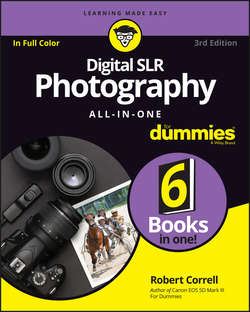Читать книгу Digital SLR Photography All-in-One For Dummies - Robert Correll - Страница 15
На сайте Литреса книга снята с продажи.
Book 1
Pursuing Digital SLR Photography
Chapter 2
Handling, Cleaning, and Protecting Your Camera
Providing Additional Support
ОглавлениеThe best way to stabilize your camera is with a good tripod. Using a support lets you set longer shutter speeds and not worry about camera movement blurring your photos. One-legged monopods offer less support but are much more mobile.
You can mount different heads on tripods and monopods. Some pan and tilt. Others are a form of ball joint. Whichever you choose (I have both), look into getting one with a quick-release plate. You screw it into the camera bottom and then lock the plate onto the tripod head. It’s far easier to latch and unlatch the quick-release plate than it is to screw and unscrew the entire camera.
You can use a fence, a rock, a vehicle, the ground, or another item if you need to stabilize your camera and don’t have a support with you. You can also try kneeling to stabilize the camera. You may find that resting your elbow on your knee is comfortable in this position.
Tripod
I use a tripod all the time (see Figure 2-12). It’s good for ya. When taking macros or close-ups in the studio, formal portraits, or landscape shots, nothing works better at securing and supporting the weight of the camera. Cheap tripods, however, while affordable and minimally functional, are very disappointing. You really do get what you pay for. If you want something that will be stable and last for more than two days, get a name-brand tripod from a camera shop, not a discount store.
FIGURE 2-12: Tripods provide fantastic support for cameras.
Aside from providing rock-solid stability, using a tripod frees your hands and allows you to concentrate more on camera setup and framing than on supporting the camera and taking a steady shot. You won’t grow as tired, either.
Monopod
Monopods have a single leg that telescopes in and out to the height you want to work at, as shown in Figure 2-13. Most often, you see professional photographers at sporting events using monopods. They stand, sit, or kneel on the sidelines and use the monopod to support the weight of their camera. If using bulky, heavy lenses, you need all the support you can get. You’ll mount your telephoto lens right to the monopod.
FIGURE 2-13: Monopods excel at supporting large cameras and lenses.
Walking around with a monopod is much easier than lugging around a tripod. They’re faster to set up and tear down. Setting the exact height you need with one leg is easier than fiddling around with three. The tradeoff for this convenience, however, is stability and safety. Monopods aren’t as stable as tripods, and if you forget they don't have three legs and let go, well, you're in for a nasty surprise.
